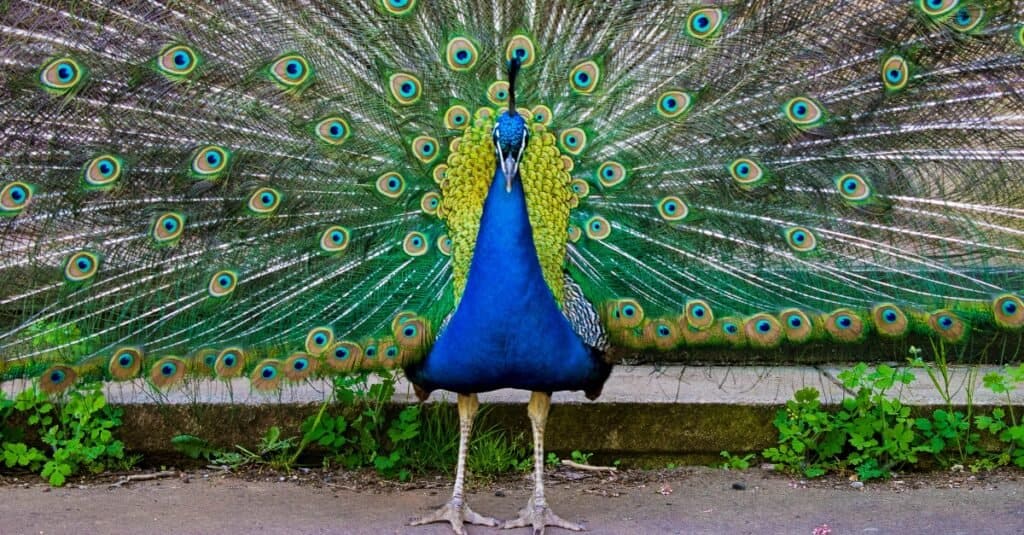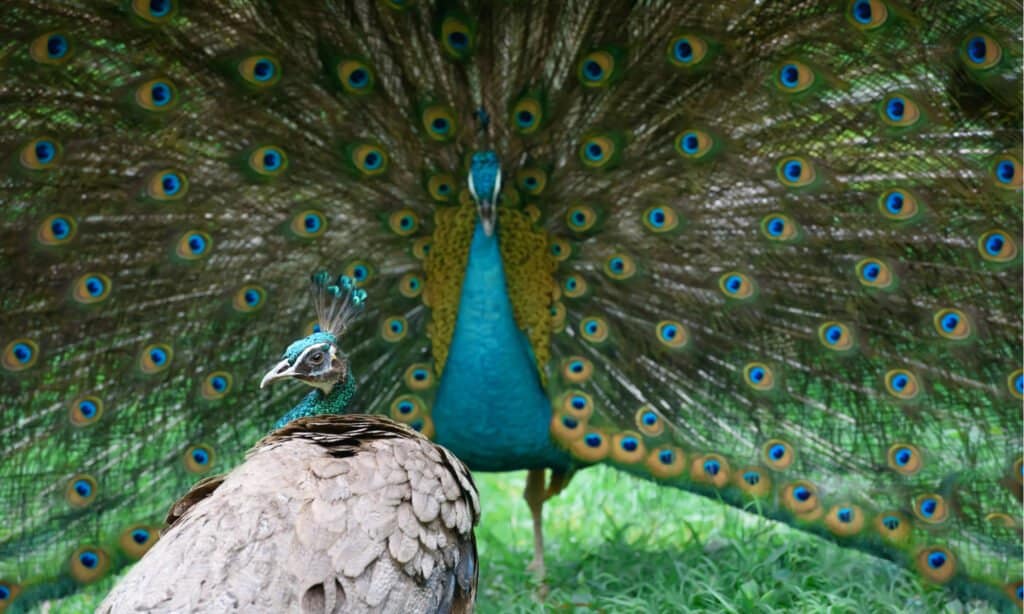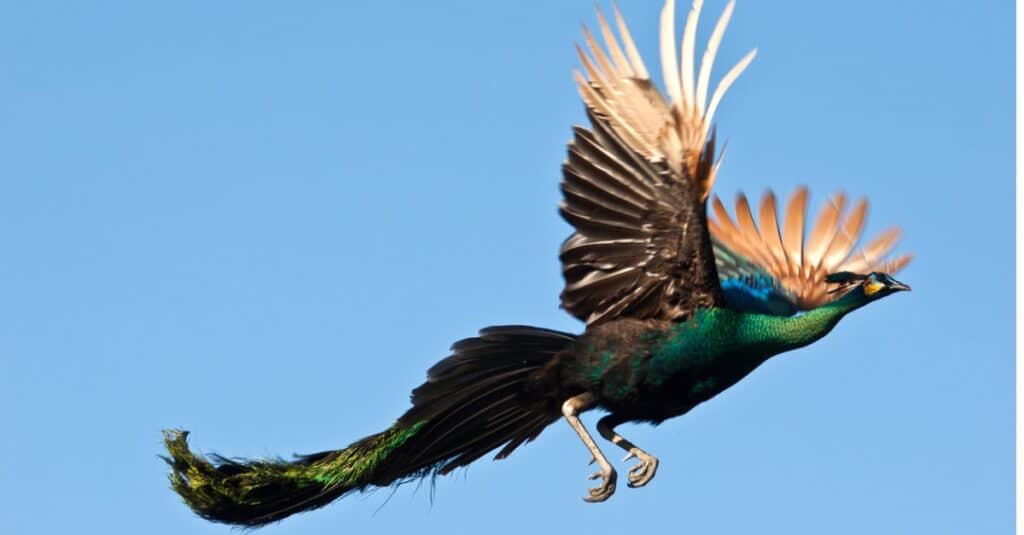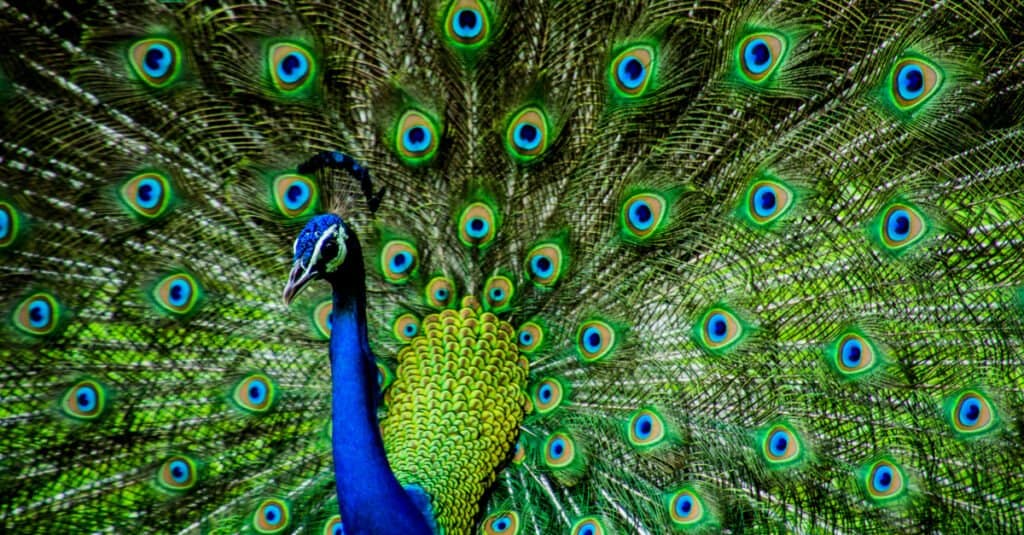No matter the gender, peacocks are stunning, but there are some key differences when comparing male vs female peacocks. Not only are males known as the more beautiful of the two birds, but male peacocks have very different behaviors when compared to female peacocks. But in what other ways do the two differ?
In this article, we will address all of the similarities and differences between male and female peacocks. Not only will you know how to tell them apart, but you will understand their behavioral differences as well as their reproductive roles.
Let’s get started!
Comparing Male vs Female Peacocks

| Male Peacocks | Female Peacocks | |
|---|---|---|
| Size | 7 feet long with tail feathers | 4 feet long with tail feathers |
| Weight | 9-15 pounds | 5-9 pounds |
| Feathers | Long and colorful tail feathers; deep green or blue coloring throughout | Lacking detailed tail feathers; found in neutral or camouflaging colors |
| Behavior | Territorial with females; impresses with their tail feathers, but does not take care of their young | Territorial with other females; tends to their young and builds nests, comfortable living in a flock environment |
| Reproduction | Mates with female peacock and otherwise lives a solitary life | Lays eggs and takes care of young, living with babies and other females |
Key Differences Between Male vs Female Peacocks

Male peacocks are larger than female peacocks in both length and weight, often by a large margin.
©iStock.com/Anna_Brothankova
The main difference between male vs female peacocks is their gender. You can easily tell the difference between these two birds given how much more colorful male peacocks are when compared to female peacocks. The sizes of these two genders of bird differ as well, with male peacocks growing larger in both size and weight when compared to female peacocks.
Let’s address all of these differences in more detail now.
Male vs Female Peacocks: Size and Weight

Male peacocks are well known for their impressive tail feathers, which female peacocks lack entirely.
©Anna Kucherova/Shutterstock.com
A key difference between male vs female peacocks is their size and weight. Male peacocks are larger than female peacocks in both length and weight, often by a large margin. For example, the average male peacock reaches 7 feet in length given their impressive tail feathers, while female peacocks have a maximum length of roughly 4 feet.
Male peacocks also weigh more than female peacocks, often to a large degree. The average female peacock or peahen weighs 5-9 pounds, while male peacocks reach 9-15 pounds on average. You may not be able to tell this by looking at them, but a male peacock’s impressive feathers should be enough to show off their size differences.
Male vs Female Peacocks: Feathers and Coloring

A male peacock is entirely green or blue in color, while female peacocks are found in more muted tones, such as cream, brown, and tan.
©iStock.com/charti1
The main way you will recognize a male peacock from a female peacock is through their feathers and colorings. Male peacocks are well known for their impressive tail feathers, which female peacocks lack entirely. However, male peacocks use their tail feathers to their advantage, as they are integral to a male peacock’s mating ritual.
Female peacocks are much more muted in their overall appearance, with only a few colored feathers on their body. A male peacock is entirely green or blue in color, while female peacocks are found in more muted tones, such as cream, brown, and tan. This is meant to be a survival mechanism for female peacocks, as their plain-colored feathers help them camouflage.
Male peacocks also use their impressive tail feathers for protection, puffing up and using them in order to appear larger. This often scares away predators or other threats, making male peacocks ideal for protecting female peacocks.
Male vs Female Peacocks: Neck and Head Appearance

While both genders of bird have unique feathers forming a crest atop their head, male peacock feather crests are blue or green in color, while female peacock feather crests are a more neutral shade of brown or cream.
©Labrador Photo Video/Shutterstock.com
Another difference between male vs female peacocks is their neck and head appearance. While both genders of bird have unique feathers forming a crest atop their head, male peacock feather crests are blue or green in color, while female peacock feather crests are a more neutral shade of brown or cream.
Both of these birds also have unique stripes or patterns around their eyes, but the markings around a female peacock’s eyes differ from the markings around a male peacock’s eyes. The markings on a female peacock often blend into their plain feather colors, while male peacock markings stand out as white on blue.
Male vs Female Peacocks: Behavior

Both of these birds also have unique stripes or patterns around their eyes, but the markings around a female peacock’s eyes differ from the markings around a male peacock’s eyes.
©Kandarp/Shutterstock.com
There are some behavioral differences between male and female peacocks. Male peacocks are well known for their ability to court female peacocks using their impressive tail, while female peacocks are primarily concerned with their survival. This leads to some behavioral differences as well as some structural differences to a peacock flock.
For example, most male peacocks live a solitary life unless they are in the process of mating, while female peacocks live in flocks of other peahens and their young. Female peacocks are also responsible for building the nests that their young will sleep in, something that male peacocks take no part in. You can also imagine that there are some reproductive differences between male and female peacocks. Let’s talk about that now.
Male vs Female Peacocks: Reproductive Capabilities

©dangdumrong/Shutterstock.com
Besides the obvious difference in gender between a male vs female peacock, there are some reproductive and parental differences between these genders as well. For example, female peacocks are capable of laying eggs, while male peacocks are not. Female peacocks also take good care of their young until they reach adulthood, while male peacocks have nothing to do with raising their own children.
Does The Peacock Mate for Life?
Peacocks are known for their open approach to polygamous relationships. After mating, male peacocks frequently separate from their female partners and actively seek out new mates.
This behavior showcases the unique and sometimes surprising social dynamics among these magnificent birds, where the pursuit of multiple partners is a common and natural part of their reproductive strategy.
Further, the peacock tail feathers feature stunning eye-like spots and in fact, a peacock can display as many as 200 feathers on its tail simultaneously, shedding them each summer.
In the wild, peacocks typically live for 15 to 20 years on average. Yet, under captivity, they can thrive for up to 40 years while breeding with many different mates.
The photo featured at the top of this post is © Anna Kucherova/Shutterstock.com
Thank you for reading! Have some feedback for us? Contact the AZ Animals editorial team.






